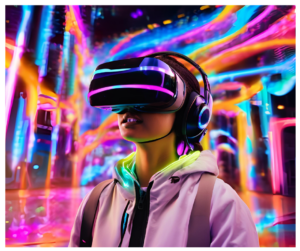
 The Future of Virtual Reality in 2025: A Gamer’s Guide to VR Tech
The Future of Virtual Reality in 2025: A Gamer’s Guide to VR Tech
Hey there! So, I’ve been diving deep into the world of virtual reality (VR) lately, and let me tell you—it’s gotten wild in 2025. We’re talking full-body immersion, no more “motion sickness” fears, and even VR that feels like you’re actually in the room with someone. Trust me, if you haven’t taken the VR plunge yet, it’s time to get on the bandwagon. Don’t worry, I’ve got your back with the inside scoop on the best VR products to buy this year and some tips on where to get them.
The Big Players: VR Headsets That Are Changing the Game
Let’s start with the obvious—VR headsets. The big dogs of 2025 are more advanced than ever, and they’re way lighter than the clunky ones from the early days.
1. Meta Quest 3 (Formerly Oculus)
Okay, we all knew Meta (formerly Oculus) was going to continue pushing the envelope. The Quest 3 is a significant step up from its predecessors, offering crystal-clear visuals with a super-powered display. With a 16 GB RAM boost, you’ll have no problem running even the most demanding VR games and experiences. What’s even cooler? You don’t need a PC or console to use it—it’s all standalone.
Pros:
- Wireless design (no cables, yay!)
- Incredible performance for a standalone headset
- Seamless integration with Facebook/Meta’s VR universe
Cons:
- Some users complain about the fit (but honestly, it’s not a deal-breaker).
Where to get it: You can snag the Meta Quest 3 at places like Amazon or Best Buy. Expect to pay around $499 for the 128 GB model, but hey, it’s worth every penny.
2. PlayStation VR2 (PS5 Exclusive)
If you’re a PlayStation fan (like me), you already know that the PS VR2 is a game-changer. This headset takes advantage of the PS5’s power to deliver some of the most stunning visuals I’ve ever seen. The 4K HDR display, combined with adaptive triggers and haptic feedback in the controllers, gives you the feeling that you’re really inside the game. Seriously, I felt like I could almost touch the horizon in Horizon: Call of the Mountain. It’s immersive, to say the least.
Pros:
- Immersive visual experience with HDR support
- Unique haptic feedback and adaptive triggers
- Must-have if you already own a PS5
Cons:
- You’ll need a PS5, which can be hard to find at times (seriously, where are they?).
Where to get it: The PlayStation VR2 is available directly through Sony or retailers like Walmart and GameStop. It’ll run you around $549 for the full bundle with controllers.
3. Valve Index (For the Hardcore Gamers)
For all you serious VR enthusiasts, the Valve Index is like the holy grail. The visuals? Ridiculously crisp. The refresh rate? 144 Hz. The field of view? 130 degrees (basically, it feels like you have a whole new set of eyes). This headset is for gamers who demand the best, but there’s a catch—it’s not as user-friendly as the Quest 3 or PS VR2. You’ll need a beefy PC, and getting the setup right can take a little time. But once it’s all configured? Total bliss.
Pros:
- Unmatched visual fidelity
- A highly customizable experience
- Ideal for gaming and productivity
Cons:
- Requires a powerful PC and lots of setup time
- Expensive, starting at around $999 for the full kit.
Where to get it: You can buy the Valve Index directly from Valve’s website or through PC-centric retailers like Newegg. Just make sure your PC is ready to handle it!
VR Accessories You Didn’t Know You Needed
Now, I can’t talk about VR in 2025 without mentioning some of the cool accessories that’ll take your experience to the next level.
TactSuit X16 Full-Body Haptic Suit
If you want to feel every explosion, punch, and bullet (without actually being hurt), you NEED the TactSuit X16. This full-body haptic suit provides feedback to your body, making it feel like you’re actually experiencing the physical sensations of the game. It’s like playing VR in a real-life action movie.
Pros:
- Super immersive, gives you physical sensations in-game
- Adjustable feedback strength
- Compatible with most VR headsets
Cons:
- A bit of a workout (which could be good or bad depending on your mood).
Where to get it: You can find the TactSuit X16 at bHaptics.com, and it’ll run you around $699.
Vive Facial Tracker
Okay, here’s the weird but awesome part—VR facial expressions. The Vive Facial Tracker lets your avatar mirror your facial expressions in real time. So if you smile, your VR character smiles. Creepy? Maybe. But it adds an extra layer of immersion for social VR apps and multiplayer games. If you’re into VR chatrooms or social games, this little guy is a game-changer.
Pros:
- Adds a fun personal touch to social VR
- Works with several VR headsets
- Light and easy to use
Cons:
- Only really useful for social VR or specific apps.
Where to get it: The Vive Facial Tracker is available at Vive.com, priced at $129.
Final Thoughts: VR in 2025 is Wild
I’m not gonna lie—VR in 2025 is better than I could’ve ever imagined. Whether you’re a casual gamer or a die-hard enthusiast, the tech is more accessible and immersive than ever before. Whether you go with the Meta Quest 3 for convenience, the PS VR2 for console gaming bliss, or the Valve Index for an elite experience, there’s something for everyone.
And remember, the accessories are what really make VR feel like a second world—so don’t sleep on the haptic suits and facial trackers. Trust me, you won’t regret it.
Catch you in the virtual world!
As an Amazon Associate, I earn a small commission. Thank you for your support! Click the images or links below to shop! #affiliate #ads


Be the first to comment